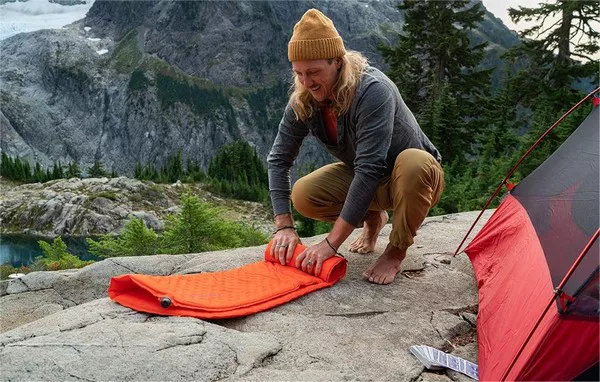Exploring the great outdoors often involves spending nights under the stars, and a good night’s sleep is essential for a successful adventure. A backcountry sleeping pad can make all the difference, providing comfort, insulation, and support in rugged environments. In this comprehensive guide, we’ll delve into the world of backcountry sleeping pads, exploring their features, types, and the best options available to help you choose the perfect pad for your outdoor pursuits.
Why Choose a Backcountry Sleeping Pad?
A backcountry sleeping pad serves several crucial purposes for campers and backpackers:
- Comfort: Sleeping pads cushion your body from the hard ground, providing a more comfortable sleeping surface than sleeping directly on the earth.
- Insulation: In cold conditions, sleeping pads provide insulation by creating a barrier between your body and the ground, helping to retain body heat and keep you warm.
- Support: A good sleeping pad helps distribute your weight evenly, reducing pressure points and promoting better sleep quality.
- Compact and Lightweight: Backcountry sleeping pads are designed to be portable and easy to carry, making them ideal for backpacking and remote camping trips.
Types of Backcountry Sleeping Pads
1. Air Pads
Air pads are inflated with air and typically offer the best comfort-to-weight ratio. They are lightweight and pack down small, making them popular among backpackers. Modern air pads often feature internal baffles or chambers that help distribute air evenly for stability and support. Some models come with insulation to improve warmth, while others prioritize minimal weight and pack size.
2. Self-Inflating Pads
Self-inflating pads combine open-cell foam insulation with an air chamber. When the valve is opened, the foam expands and draws in air, inflating the pad. They offer a good balance of comfort, insulation, and convenience. Self-inflating pads are durable and provide consistent performance even in rugged conditions. They are slightly heavier and bulkier than air pads but are valued for their reliability and ease of use.
3. Foam Pads
Foam pads are made from closed-cell or open-cell foam and are known for their durability and affordability. Closed-cell foam pads are lightweight, non-inflatable, and provide excellent insulation and puncture resistance. They are often used as a backup pad or in combination with other pads for added comfort and insulation. Open-cell foam pads are softer and more comfortable but are less durable and bulkier than closed-cell foam pads.
Key Features to Consider
When choosing a backcountry sleeping pad, consider the following features:
- R-Value: The R-value indicates the thermal resistance of the pad and its ability to insulate. A higher R-value means better insulation, important for cold weather camping.
- Weight: Backpackers prioritize lightweight gear, so consider the weight of the sleeping pad, especially if you’ll be carrying it over long distances.
- Size and Packability: Look for a sleeping pad that packs down small and fits easily into your backpack. Pay attention to both packed size and inflated dimensions.
- Comfort: Consider the thickness and surface texture of the pad for comfort. Thicker pads generally offer more cushioning but may be heavier.
- Durability: Choose a sleeping pad made from durable materials that can withstand rough terrain and frequent use.
Top Backcountry Sleeping Pads on the Market
Now, let’s explore some of the best backcountry sleeping pads available, each offering unique features suited to different camping preferences and conditions.
1. Therm-a-Rest NeoAir XTherm
The Therm-a-Rest NeoAir XTherm is a top choice for backpackers seeking exceptional warmth and comfort in cold conditions. Key features include:
- High R-Value: With an R-value of 6.9, the NeoAir XTherm provides excellent insulation for winter camping.
- Ultralight Construction: Despite its warmth, the pad is lightweight and packs down small, ideal for backpacking.
- Triangular Core Matrix Construction: This design minimizes convective heat loss and provides stability.
- Reflective ThermaCapture Technology: Reflects radiant heat back to your body for added warmth.
2. Sea to Summit Ultralight Insulated
The Sea to Summit Ultralight Insulated sleeping pad is designed for backpackers who prioritize comfort and packability. Key features include:
- Air Sprung Cells: These cells conform to your body shape for enhanced comfort and support.
- Exkin Platinum Insulation: Provides warmth without adding bulk, suitable for three-season camping.
- Multifunction Valve: Allows for easy inflation, deflation, and fine-tuning of air pressure.
- Lightweight and Packable: Weighs just under 1 lb and packs down to a small size.
SEE ALSO: THE BEST AIR MATTRESS FOR CAMPING WITH DOGS
3. NEMO Tensor Insulated
The NEMO Tensor Insulated sleeping pad combines lightweight design with plush comfort for a restful night’s sleep. Key features include:
- Spaceframe Baffles: Provides stability and support without adding weight.
- PrimaLoft Insulation: Offers warmth even in colder temperatures.
- Included Vortex Pump Sack: Makes inflation fast and easy without introducing moisture into the pad.
- Integrated Pillow Baffle: Allows clothing or a stuff sack to be used as a pillow for added comfort.
4. Big Agnes Q-Core SLX
The Big Agnes Q-Core SLX is a luxurious option for campers who value comfort and durability. Key features include:
- Minimalist I-Beam Construction: Reduces weight while providing stability and support.
- X-Static Insulation: Controls odor and regulates temperature.
- High-Flow Valve: Allows for easy inflation and deflation.
- Antimicrobial Treatment: Prevents mold and mildew growth.
Conclusion
Choosing the best backcountry sleeping pad depends on your specific needs, including the climate you’ll be camping in, your comfort preferences, and how much weight you’re willing to carry. The Therm-a-Rest NeoAir XTherm, Sea to Summit Ultralight Insulated, NEMO Tensor Insulated, and Big Agnes Q-Core SLX are among the top-rated options, each offering unique features tailored to different camping scenarios.
When selecting a sleeping pad, prioritize factors such as R-value for insulation, weight for portability, comfort for a restful sleep, and durability for long-lasting performance. By investing in a quality backcountry sleeping pad, you can enhance your outdoor experience and enjoy a more comfortable and rejuvenating night under the stars.

